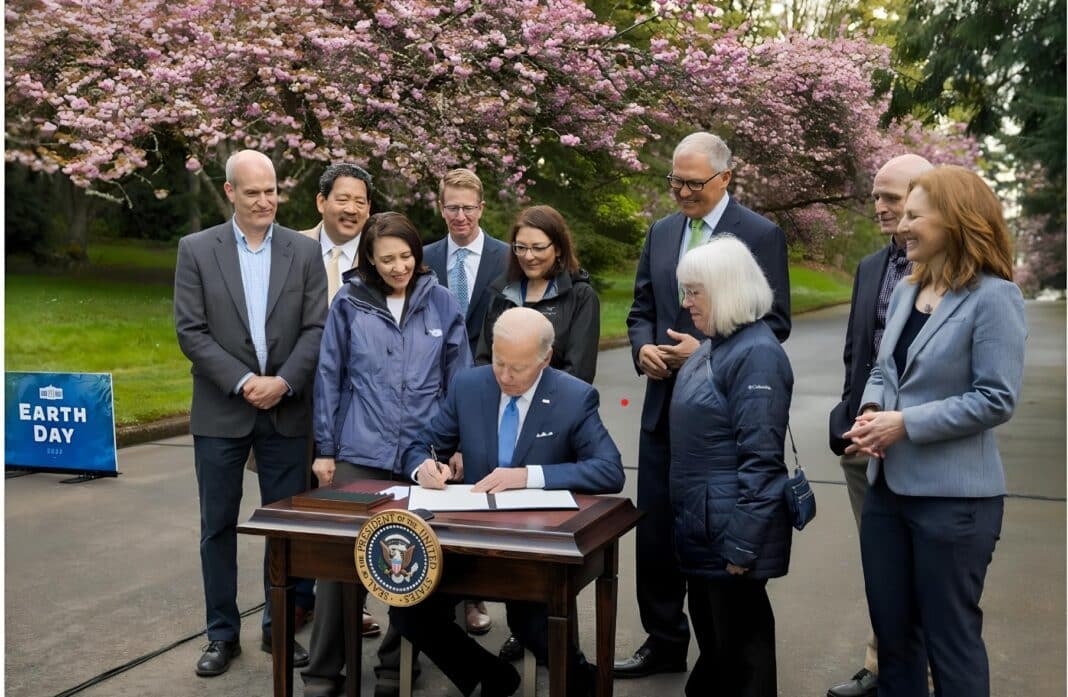Less than five months before the presidential election, logging has emerged as a hot-button political issue, with President Biden and former President Donald Trump clashing over how old-growth forests should be managed.
Today, President Biden promised to effectively halt all logging in old-growth forests – with the administration publishing a new plan, which, if elected, will apply to more than 32 million acres of forests managed by the US Forest Service and the Department of the Interior’s Bureau of Land Management.
It comes after officials rejected a blanket prohibition on old-growth logging (and mature forests), which environmentalists have long sought. Officials concluded that a sweeping ban on old-growth forests would make it harder to thin forests to better protect communities against wildfires that have grown more severe as the planet has warmed.
“To ensure the longevity of old-growth forests, we’re going to have to take proactive management to protect against wildfire and insects and disease,” Forest Service Deputy Chief Chris French told the Associated Press today. “Without some thinning allowed on these forests,” he said, “there is a risk of losing more trees.”
US Forest Service argues that the impact on the timber industry will be minimal.
The new rules are unlikely to placate the timber industry and Congress Republicans, who have pushed back against any new restrictions. However, Mr French asserts that the impacts on timber companies would be minimal.
“There’s so little timber sales that occur right now in old-growth … that the overall effects are very small,” Mr French said.
According to government data, the timber industry employs 860,000 people, which is about 30% fewer than in 2001. In recent years, much of their work has shifted to timber from private and state lands after harvests from national forests dropped sharply beginning in the 1990s due to new policies, changing lumber markets.
The new analysis comes after a separate report on threats to old-growth forests concluded that wildfires, insects and disease had been the main killers of old-growth trees since 2000, accounting for almost 1,400 square miles (3,600 square kilometres) of losses.
By contrast, logging on federal lands cut down about 14 square miles (36 square kilometres) of old-growth forests. Timber industry representatives have seized on that figure, arguing that further restrictions aren’t needed.
“A binding restriction on timber harvest is not where their priority ought to be,” said Bill Imbergamo of the Federal Forest Resource Coalition, an industry group. He added that exceptions by federal officials to allow some logging could be challenged in court, which could tie up even small logging projects that are focused on reducing wildfire risks.
Biden’s executive order: Democrats to end native logging by 2025
The plan comes after an executive order signed by the president on Earth Day in 2022, directing the US Forest Service and the Land Management Bureau to conduct an inventory of old-growth and mature forests and develop policies to protect them.
“We think this will allow us to respond effectively and strategically to the biggest threats that face old growth,” the US Agriculture Secretary Tom Vilsack told the Washington Post in December last year. “At the end of the day, it will protect not just the forests but also the culture and heritage connected to the forests.”
The US Forest Service oversees 193 million acres (or 78 million hectares) of forests and grasslands, of which 144 million (58 million hectares) are forests. Its inventory found that 80% was either old-growth or mature forests, with 32 million acres (12 million hectares) and 80 million (32 million hectares) of mature forests on federal land.
The Land Management Bureau defines old-growth forests as those with trees in later stages of stand development, typically at least 120 years of growth, depending on species. In 2022, shortly before Biden announced his executive order, a group of more than 130 scientists wrote a letter to Biden advocating a ban on logging in old-growth forests.
“Older forests provide the most above-ground carbon storage potential on Earth, with mature forests and larger trees driving the most accumulation of forest carbon in the critical next few decades,” the letter read. “Left vulnerable to logging, though, they cannot fulfil these vital functions.”
The ban, now conditional on President Biden being reelected, will come into effect in early 2025, allowing the Forest Service to finalise rules protecting old-growth forests from logging.
Under President Donald Trump, federal officials sought to open up huge areas of West Coast forests to potential logging. That policy was reversed in 2021 after federal wildlife officials determined that appointees under the Trump administration used faulty science to justify drastically shrinking areas of forest that are considered crucial habitats for endangered species.
Old-growth forests: When does a forest grow old?
President Biden’s order to protect the nation’s oldest forests has raised a simple yet vexing question: When does a forest grow old?
Old-growth forests, such as the storied giant sequoia stands of Northern California, have layers of undisturbed trees and vegetation. There’s wide consensus on the importance of preserving them — symbolically and practically because their trunks and branches store large amounts of carbon that can be released when forests burn, adding to climate change.
Most old-growth forests were lost to logging as the nation developed over the past few centuries. Yet pockets of ancient trees remain, scattered across the U.S., including in California, the Pacific Northwest and areas of the Rocky Mountains. Larger expanses of old growth survive in Alaska, such as within the Tongass National Forest.
- To learn more about what defines old-growth forests and how they differ from mature forests, visit the Associated Press’s special feature.






